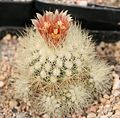This article includes a list of general references, but it lacks sufficient corresponding inline citations .(December 2021) |
| Acharagma | |
|---|---|
 | |
| Acharagma roseana | |
| Scientific classification | |
| Kingdom: | Plantae |
| Clade: | Tracheophytes |
| Clade: | Angiosperms |
| Clade: | Eudicots |
| Order: | Caryophyllales |
| Family: | Cactaceae |
| Subfamily: | Cactoideae |
| Tribe: | Cacteae |
| Genus: | Acharagma (N.P.Taylor) Zimmerman ex Glass [1] |
| Type species | |
| Acharagma aguirreanum | |
| Species | |
| Synonyms | |
| |
Acharagma is a genus of two cactus species from northern Mexico. [1]


